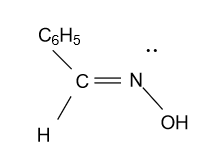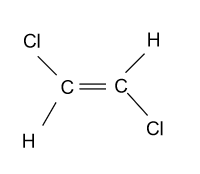
Which of the following cannot exhibit stereo-isomerism.
(A)-${\text{C}}{{\text{H}}_{\text{3}}}{\text{CH}}\left( {{\text{Cl}}} \right){\text{COOH}}$
(B)-${{\text{C}}_{\text{6}}}{{\text{H}}_{\text{5}}}{\text{CH = NOH}}$
(C)-${\text{ClCH = CHCl}}$
(D)-${\text{ClCH = C}}{{\text{H}}_{\text{2}}}$
Answer
555k+ views
Hint: Stereoisomers show by those isomers which have the same molecular formula but showing different structures due to different arrangements of atoms or bonds in the space of the given molecule. Those molecules which show optical activity or geometrical isomerism also come under stereo-isomers.
Complete answer:
-In the option (A), compound ${\text{C}}{{\text{H}}_{\text{3}}}{\text{CH}}\left( {{\text{Cl}}} \right){\text{COOH}}$ is given which is showing optical activity or optical isomerism due to the presence of chiral carbon center in it.

In the above figure, optical activity is shown due to the center carbon because all 4 vacancies are fulfilled by 4 different groups that’s why it is chiral carbon.
-In the option (B), compound ${{\text{C}}_{\text{6}}}{{\text{H}}_{\text{5}}}{\text{CH = NOH}}$ is given which is showing geometrical isomerism due to the presence of double bond and different arrangements of substituents present on carbon and nitrogen atom attached to double bond.

In the above figure a lone pair present on a nitrogen atom behaves as a substituent group on nitrogen and showing geometrical isomerism.
-In the option (C), compound ${\text{ClCH = CHCl}}$ is given which is showing geometrical isomerism due to the presence of double bond, 2 different groups on each carbon atom and different arrangements of substituents.

-In the option (D), compound ${\text{ClCH = C}}{{\text{H}}_{\text{2}}}$ is given which is not showing stereo isomerism due to the absence of chiral carbon and presence of 2 same group i.e. hydrogen on one carbon atom.
Hence, option (D) i.e. ${\text{ClCH = C}}{{\text{H}}_{\text{2}}}$ among all given compounds cannot exhibit stereo-isomerism.
Note: In finding stereoisomers never get confused with the structural isomerism, because there is only a very small difference between structural and stereoisomers. So, always keep in mind that in structural isomers chiral carbon is not present.
Complete answer:
-In the option (A), compound ${\text{C}}{{\text{H}}_{\text{3}}}{\text{CH}}\left( {{\text{Cl}}} \right){\text{COOH}}$ is given which is showing optical activity or optical isomerism due to the presence of chiral carbon center in it.

In the above figure, optical activity is shown due to the center carbon because all 4 vacancies are fulfilled by 4 different groups that’s why it is chiral carbon.
-In the option (B), compound ${{\text{C}}_{\text{6}}}{{\text{H}}_{\text{5}}}{\text{CH = NOH}}$ is given which is showing geometrical isomerism due to the presence of double bond and different arrangements of substituents present on carbon and nitrogen atom attached to double bond.

In the above figure a lone pair present on a nitrogen atom behaves as a substituent group on nitrogen and showing geometrical isomerism.
-In the option (C), compound ${\text{ClCH = CHCl}}$ is given which is showing geometrical isomerism due to the presence of double bond, 2 different groups on each carbon atom and different arrangements of substituents.

-In the option (D), compound ${\text{ClCH = C}}{{\text{H}}_{\text{2}}}$ is given which is not showing stereo isomerism due to the absence of chiral carbon and presence of 2 same group i.e. hydrogen on one carbon atom.
Hence, option (D) i.e. ${\text{ClCH = C}}{{\text{H}}_{\text{2}}}$ among all given compounds cannot exhibit stereo-isomerism.
Note: In finding stereoisomers never get confused with the structural isomerism, because there is only a very small difference between structural and stereoisomers. So, always keep in mind that in structural isomers chiral carbon is not present.
Recently Updated Pages
A man running at a speed 5 ms is viewed in the side class 12 physics CBSE

State and explain Hardy Weinbergs Principle class 12 biology CBSE

Which of the following statements is wrong a Amnion class 12 biology CBSE

Two Planoconcave lenses 1 and 2 of glass of refractive class 12 physics CBSE

The compound 2 methyl 2 butene on reaction with NaIO4 class 12 chemistry CBSE

Bacterial cell wall is made up of A Cellulose B Hemicellulose class 12 biology CBSE

Trending doubts
What are the major means of transport Explain each class 12 social science CBSE

Which are the Top 10 Largest Countries of the World?

Draw a labelled sketch of the human eye class 12 physics CBSE

Explain sex determination in humans with line diag class 12 biology CBSE

The pH of the pancreatic juice is A 64 B 86 C 120 D class 12 biology CBSE

Give 10 examples of unisexual and bisexual flowers




